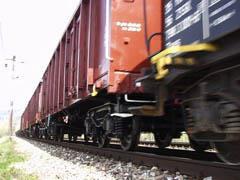
Sir - Your report about DB’s attempts to undermine the freight-oriented network proposals accords with the feelings of a Europe-wide grouping of customers, shippers, forwarders, independent train operators and others. We welcome the proposal by the European Commission to improve the quality, performance and viability of rail freight on the main corridors across Europe.
These groups and companies comprise the majority of the European transport and logistics industry, traders, manufacturers and many train operators, who all wish to increase their use of rail. They have been calling on the Commission, the European Parliament and the Council of Ministers for more than two years to create a rail network partly or wholly dedicated to freight, so that they can obtain or provide efficient, cost-effective and reliable services. They may compete with each other and with other modes but they all need a single market for freight on rail as is the case for other modes of transport.
The draft Regulation would provide much of what customers and DB’s competitors believe is necessary to obtain efficient and reliable services across Europe. But it seems as if DB has misunderstood, intentionally or mistakenly, the difference between the proposal to reserve sensible paths for freight trains along whole Trans-European Network (TEN-T) routes with the need for procedures to deal with disruption on the network. Co-ordination of train planning has nothing to do with dealing with network perturbation, which can and should be dealt with locally.
Reserving through paths for freight as well as passenger trains would reduce the risk of trains being delayed at the borders. In some member states, new entrants find it difficult or impossible to get paths at all, and have to rely on going from point to point and then phoning the signalbox to get onto the next section of track. That is what happens to DB’s subsidiary in France, and the company complains strongly about such treatment whilst resisting any similar attempt by SNCF to get better paths in Germany.
The fact is that infrastructure managers do not co-ordinate their timetables well, and this is why the Commission is insisting that they be required to do so. Setting up of a governance body for each route would bring together the various infrastructure managers to drive forward plans for improving the performance of freight, capacity and investment.
DB objects to the idea that capacity should be ‘determined on the basis of market studies and in consultation with potential users of the corridors’ but who better to determine future demand for capacity than the operators and customers who might want to use it? Another part of the draft Regulation requires the corridor management body to ensure that there is a sufficient supply of open access terminals at strategic locations along a route. This is a key element in encouraging open access operators, but it must include all the essential services needed in a terminal. Crucially, the corridor managers are required to take into account the views of terminal operators in developing their corridor plans.
There must also be space for passenger trains, and clearly discussions will be needed at the timetabling stage to create the necessary long-distance paths and ensure that investment in a corridor is co-ordinated between member states. It is pointless to invest in sidings to take an 800 m train on one part of a corridor if the adjacent member state only allows 500 m.
However, there is much more to the draft Regulation than arguing as to whether we should have one network management for a corridor. Train operators and customers need a highly-efficient rail infrastructure; at present, 60% of all incidents encountered by private and independent rail freight undertakings originate from the infrastructure. The proposal tackles the core of many delays and sub-standard services and would help make rail freight more attractive.
So the real issue here is one of control – who allows which trains onto the tracks of a member state? Why do they get so precious about this? Surely they all recognise that co-ordination between member states and their respective infrastructure managers is essential, but the voluntary route has manifestly failed.
Some member states actually have a considerable interest in getting a rail freight network and they are expecting their neighbours to extend their national efforts so that trains finally operate as if they were part of a single market. Examples such as the Betuwe Route in the Netherlands have shown to what extent ‘island’ approaches can prevent rail freight from operating seamlessly across borders. An integrated network based on best-practice network management will support both incumbents operating internationally as well as those of new entrants … to the pure delight of their customers!
The European Parliament and the Council of Ministers should strengthen rather than weaken these proposals, and demonstrate their commitment to creating a single market in rail freight.
Tony Berkeley
President, European Rail Freight Association
Member of the House of Rail
House of Lords, London, UK

















